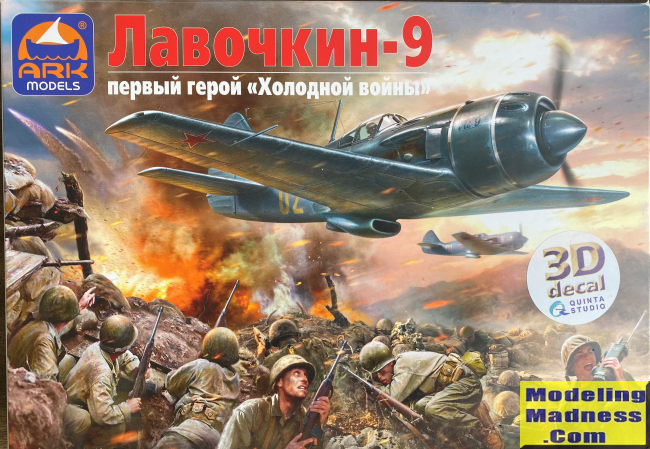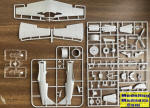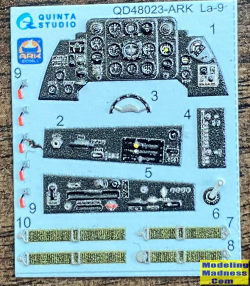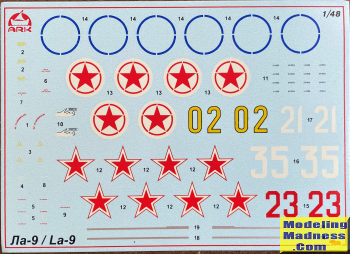
| KIT #: | AK 48049 |
| PRICE: | $19.00 from e-paid |
| DECALS: | Four options |
| REVIEWER: | Zac Yates |
| NOTES: | 3D decals provided |

| HISTORY |
The Lavochkin La-9 and its follow-up the La-11 were the pinnacle of Soviet piston-powered fighters, often compared to the Grumman Bearcat and Hawker Sea Fury in terms of performance. Powered by the 14-cylinder Shvetsov ASh-82FN producing 1850hp, the La-9 could reach a top speed of 430mph at altitude. It received the reporting name Fritz but Iíve not seen this used very much. The saw service in the Korean War and was used by the air forces of the Peopleís Republic of China, North Korea, Romania and the Soviet Union as well as five examples which went to the East German Volkspolizei. Upon retirement only half a dozen were left for museum display throughout the Eastern Bloc.
The La-9 was largely unknown to the West outside those with an interest in Soviet aviation history until New Zealand-born UK warbird pilot the late Ray Hanna acquired an example from a Chinese museum in exchange for a Harrier GR.3, a process that took a decade of delicate negotiations. The aircraft was restored to fly in New Zealand and originally wore Chinese markings before their embassy took exception, upon which it became Soviet White 28. It performed for the 2003 season at Duxford in the UK and airshow crowds were enraptured by the performance of the La-9 as expertly flown by Hanna and fellow Kiwis Keith Skilling and John Lamont. The speed and manoeuvrability of the aircraft were a revelation to enthusiasts more used to Western machines and they were understandably disappointed when the aircraft returned to New Zealand the following year.
But their loss was New Zealandís gain as the aircraft went on to perform at several Warbirds Over Wanaka airshows with Lamont as display pilot. When the aircraft began its takeoff roll at the 2004 show I was in the crowd and instantly fell in love with the loud, unique-sounding, and very charismatic aeroplane. In Lamontís hands the polished display showed how far piston-engined fighter design progressed in a decade compared to the Polikarpov fighters Iíd seen earlier in the day.
Writing for Aeroplane Monthly magazineís December 2004 issue, Ray Hanna described flying the Lavochkin: "(Ö) my first impression after I flew the La-9 was that it was superior in every respect to the Hawker Fury and Grumman Bearcat, which were produced at the same time. Now that I have flown it about a dozen times I maintain my initial thinking, purely from the performance point of view. The La-9 is on top of the Fury and Bearcat for max speed at low level, acceleration, rate of climb, rate of roll and turning performance. Because of its laminar-flow wing you would expect it would not turn better than the Fury and the Bearcat. That is not the case. It also has far better control harmony than its Western counterparts."
In 2010 the sole airworthy La-9 was sold to Jerry Yagen for his Military Aviation Museum at Virginia Beach but has yet to fly in the USA.
| THE KIT |
 The full colour box top
slips over a strong cardboard box which contains two grey sprues and one clear
containing 61 parts. This is the first time Iíve encountered mould release agent
so a quick wash may be needed for your copy.
The full colour box top
slips over a strong cardboard box which contains two grey sprues and one clear
containing 61 parts. This is the first time Iíve encountered mould release agent
so a quick wash may be needed for your copy.
There are 10 steps to the Instructions (in Russian and English but the
historical information is in Russian only), unfortunately references will be
needed as there are no colour callouts at all until you get to the exterior
finish. There are also no build options such as lowered flaps or an open canopy
Ė only a closed canopy is included. Two, in fact, the other no doubt for an
La-11 boxing. Unfortunately both canopies in my kit have a moulding flaw across
the side of the sliding portion.
The panel lines are quite deep and most will feel the
need to fill them, whereas the belly and wing panel fairings stand too proud of
the surface but have rivet detail which would need to be replicated if sanded
down. The ribs on the separate ailerons are more pronounced than the rudder and
elevators which are, accurately, more subdued. There is a little wheel well
detail but (compared to photos of the restored example mentioned above) more is
needed such as a fair amount of plumbing.
Thereís no engine detail as thereís a cooling fan in the way, and nice big
openings for exhaust stacks but unfortunately none are included. This will
definitely need to be addressed otherwise one will have black holes either side
of the rear cowling.
The rudder pedals are different to the restored example, missing plates on the
lower part of the pedals, and the control stick is missing the prominent brake
lever. Additionally thereís no detail at all on the
 instrument panel, side
consoles or sidewalls, and no belts. But some examples of this kit come with a
set of exquisite Quinta Studio 3D decals which add all of these. My copy is one
of those with the Quinta set and I am intrigued and excited to try them out. For
those who miss out on the Quinta deal the set is sold separately and there are
other after
instrument panel, side
consoles or sidewalls, and no belts. But some examples of this kit come with a
set of exquisite Quinta Studio 3D decals which add all of these. My copy is one
of those with the Quinta set and I am intrigued and excited to try them out. For
those who miss out on the Quinta deal the set is sold separately and there are
other after market resin sets which may fit this kit. Even with the kit canopy
there is a lot of empty space so youíll need something!
market resin sets which may fit this kit. Even with the kit canopy
there is a lot of empty space so youíll need something!
Clear parts are moderately thick and nicely clear but both canopies have
identical moulding flaws on opposite sides.
The decals are thin and in register with minimal film, and the stencils are
readable without a magnifying glass. The options are all in overall grey and I
give you their names as they appear on the separate, glossy markings guide:
Soviet VVS La-9 (White 21); The La-9 of Borisoglebsk Flight School, 1950 (White
35); North Korean Air Fors[sic] La-9 (Red 23); and Soviet VVS La-9 (Yellow 02).
The colours given are only generic Grey, Black, White, Yellow and Metal. Again,
references will be needed.
| CONCLUSIONS |
You may guess from the History section that Iím something of an La-9 fan and youíd be right. Because of the low price of the kit I wasnít expecting an Eduard-level kit and was not surprised, however at this stage in our hobbyís evolution Iím surprised the surface detail is so overdone and the interior so bland. The fact the eBay seller was offering the standard kit and the one with the Quinta 3D decals included at the same price made purchasing the latter a no-brainer and I highly recommend that option. The only other 1/48 La-9 is Mikro Mirís and based on sprue photos it looks to be even simpler than this one so I think I made the right choice.
| REFERENCES |
Kiwi Aircraft Images http://www.kiwiaircraftimages.com/la9.html
multiple Google Images searches
Personal and Dadís photographs
November 2021 Copyright ModelingMadness.com. All rights reserved.
No reproduction in part or in whole without express permission. If you would like your product reviewed fairly and fairly quickly, please
contact
the editor or see other details in the
Note to
Contributors.